
Lake Malawi, also known as Lake Nyasa in Tanzania and Lago Niassa in Mozambique, is an African Great Lake and the southernmost lake in the East African Rift system, located between Malawi, Mozambique and Tanzania.

Mbuna is the common name for a large group of African cichlids from Lake Malawi, and are members of the haplochromine family. The name mbuna means "rockfish" in the language of the Tonga people of Malawi. As the name implies, most mbuna are cichlids that live among the piles of rocks and along the rocky shores of Lake Malawi, as opposed to the utaka, cichlids that live in the open water or on sandy shores or soft substrates. Some species of mbuna are highly sexually dimorphic, although many are not. Almost all of the cichlid species of Lake Malawi, including mbuna and non mbuna such as the utaka, are believed to have descended from one or a very few species that became isolated in the lake. With rising water levels, new habitats could be colonized and the many isolated rocky outcrops allowed new mbuna species to form. Their striking colors, intriguing behavioral characteristics, and relative hardiness make them very popular despite their unique demands for the home aquarist.

Pseudotropheus is a genus of fishes in the family Cichlidae. These mbuna cichlids are endemic to Lake Malawi in Eastern Africa.

Maylandia or Metriaclima is a genus of haplochromine cichlids endemic to Lake Malawi in East Africa. They belong to the mbuna (rock-dwelling) haplochromines.

Melanochromis is a genus of haplochromine cichlids endemic to Lake Malawi in Eastern Africa. Ecologically, they belong to the rock-dwelling mbuna cichlids of Lake Malawi.
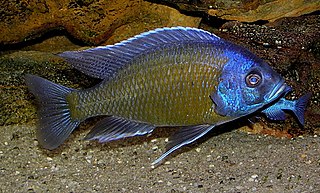
Copadichromis is a genus of haplochromine cichlids endemic to Lake Malawi in Eastern Africa. Copadichromis are part of a group known as utaka and are popular with aquarists, as this genus is relatively peaceful in captivity compared to the mbuna.

Iodotropheus is a small genus of cichlids endemic to Lake Malawi in east Africa. The genus is distinguished from other genera of mbuna by the upper lip which is usually connected medially to the skin of the snout by a frenum; by its small, terminal mouth; by the outer teeth of both jaws, which are unequally bicuspid and loosely spaced, the tooth shafts inclined slightly toward the jaw symphysis; by the anterior teeth of the upper jaw being much longer and more robust than the lateral and posterior teeth. The rusty cichlid or lavender mbuna, Iodotropheus sprengerae is the most commonly encountered member of the genus in the aquarium trade.

Otopharynx is a genus of haplochromine cichlids endemic to Lake Malawi in Eastern Africa.
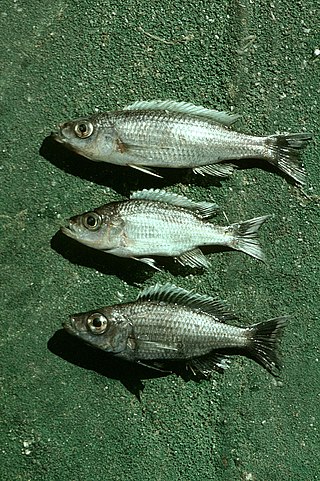
Diplotaxodon is a small genus of seven formally described, as well as a number of undescribed, deep-water species of cichlid fish endemic to Lake Malawi in east Africa. These fishes represent a remarkable adaptive radiation of offshore and deep-water adapted fish descended from ancestral shallow water forms. They include the dominant zooplankton-feeding fish of the offshore and deep-water regions of the lake, as well as a number of larger species that appear to feed on small pelagic fishes. Adult sizes range from 10 to 30 cm in total length, depending on species.

Cynotilapia afra, the afra cichlid or dogtooth cichlid, is a small species of cichlid fish from Lake Malawi in East Africa, where found in rocky habitats.
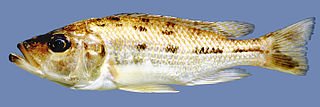
Hemitaeniochromis urotaenia is a species of fish endemic to Lake Malawi in East Africa. It is the type species of the genus Hemitaeniochromis, and is part of family Cichlidae in subfamily Pseudocrenilabrinae and the tribe Haplochromini.
Adrianus Franciscus Johannes Marinus Maria "Ad" Konings is an ichthyologist originally trained in medicine and biology. Konings is best known for his research on African rift lake cichlids. After studies in Amsterdam, he has spent most of his life in Rotterdam.

Cynotilapia axelrodi is a species haplochromine cichlid which is endemic to Lake Malawi where it occurs in Nkhata Bay and Chirombo Point, Malawi.
Microchromis zebroides is a species of cichlid endemic to Lake Malawi where it is only known to occur around Likoma Island where it prefers shallow, rocky areas. This species can reach a length of 8.6 centimetres (3.4 in) TL. This species can also be found in the aquarium trade where it is known as the Mini-zebra.
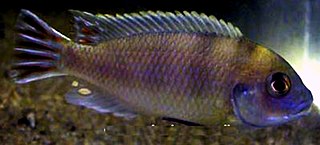
Maylandia livingstonii is a species of cichlid native to Lake Malawi and Lake Malombe. This species can reach a length of 15 centimetres (5.9 in) TL. It can also be found in the aquarium trade. The specific name of this fish honours the Scottish explorer and missionary David Livingstone (1813-1873).

Melanochromis loriae is a species of cichlid in the Cichlidae endemic to Lake Malawi. This species can reach a length of 12.5 centimetres (4.9 in) TL.
Petrotilapia is a genus of cichlids endemic to Lake Malawi.
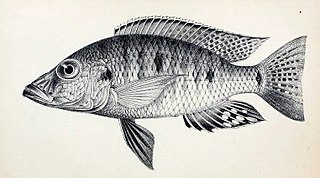
Stigmatochromis is a small genus of haplochromine cichlids that are endemic to Lake Malawi in East Africa.
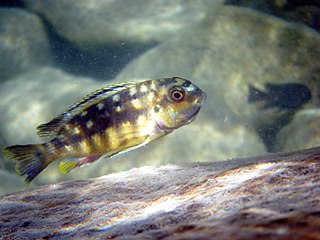
Tropheops is a genus of cichlids endemic to Lake Malawi.

Chindongo is a genus of haplochromine cichlids, the species of which are endemic to Lake Malawi. The genus was described in 2016 with Chindongo bellicosus as the type species, the authors then added species previously classified in the genus Pseudotropheus in the P. elongatus species complex.

















